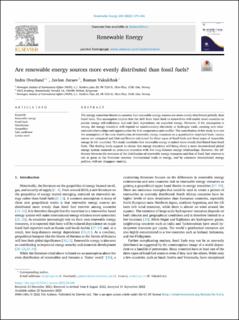| dc.contributor.author | Øverland, Indra | |
| dc.contributor.author | Juraev, Javlon | |
| dc.contributor.author | Vakulchuk, Roman | |
| dc.date.accessioned | 2022-11-24T09:22:04Z | |
| dc.date.available | 2022-11-24T09:22:04Z | |
| dc.date.created | 2022-11-18T13:11:28Z | |
| dc.date.issued | 2022 | |
| dc.identifier.citation | Renewable Energy. 2022, 200 379-386. | en_US |
| dc.identifier.issn | 0960-1481 | |
| dc.identifier.uri | https://hdl.handle.net/11250/3033797 | |
| dc.description.abstract | The energy transition literature assumes that renewable energy sources are more evenly distributed globally than fossil fuels. This assumption implies that the shift from fossil fuels to renewables will enable more countries to pursue energy self-sufficiency and end their dependence on imported energy. However, if the assumption is wrong, the energy transition will depend on transboundary electricity or hydrogen trade, creating new international relationships and opportunities for both cooperation and conflict. The contribution of this study is to test the assumption of the even distribution of renewable energy resources on a quantitative empirical basis. Lorenz curves are compared and Gini coefficients calculated for three types of fossil fuels and three types of renewable energy in 161 countries. The study concludes that renewable energy is indeed more evenly distributed than fossil fuels. This finding lends support to claims that energy transition will bring about a more decentralized global energy system centered on prosumer countries with few long-distance energy relationships. However, the difference between the evenness of the distribution of renewable energy resources and that of fossil fuel reserves is not as great as the literature assumes. International trade in energy, and by extension international energy politics, will not disappear entirely. | |
| dc.description.abstract | Are renewable energy sources more evenly distributed than fossil fuels? | |
| dc.language.iso | eng | en_US |
| dc.rights | Navngivelse 4.0 Internasjonal | * |
| dc.rights.uri | http://creativecommons.org/licenses/by/4.0/deed.no | * |
| dc.title | Are renewable energy sources more evenly distributed than fossil fuels? | en_US |
| dc.title.alternative | Are renewable energy sources more evenly distributed than fossil fuels? | en_US |
| dc.type | Peer reviewed | en_US |
| dc.type | Journal article | en_US |
| dc.description.version | publishedVersion | |
| dc.source.pagenumber | 379-386 | en_US |
| dc.source.volume | 200 | en_US |
| dc.source.journal | Renewable Energy | en_US |
| dc.identifier.doi | 10.1016/j.renene.2022.09.046 | |
| dc.identifier.cristin | 2076362 | |
| cristin.ispublished | true | |
| cristin.fulltext | original | |
| cristin.qualitycode | 1 | |

